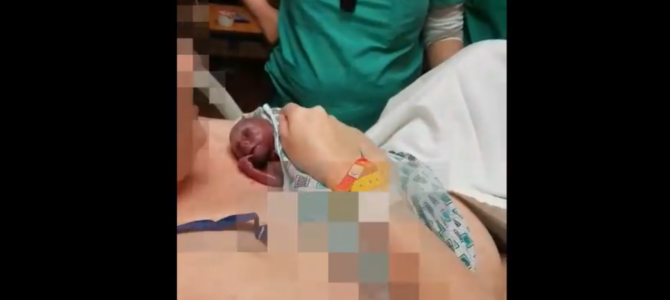
On June 24, 2017, Emery Finnefrock lived for 45 minutes after he was born at 22 weeks and 5 days gestation, and received no neonatal intensive care or treatment. His twin brother, Elliot Finnefrock, was born shortly after and lived for 2 hours and 30 minutes, breathing and crying as hospital staff again refused to provide treatment.
“Mommy tried … Mommy tried,” the boys mother, Amanda Finnefrock, is heard saying on a video capturing the moments post-delivery at Riverside Methodist Hospital in Columbus, Ohio.
According to existing federal law, treatment should have never been withheld from the twin boys. The Emergency Medical Treatment and Labor Act (EMTALA) passed in 1984 guarantees an individual’s right to an appropriate medical screening examination and to either stabilizing treatment or an appropriate transfer. A Health and Human Services investigation of the Finnefrock twins’ case determined that Riverside staff violated EMTALA when they failed to conduct a screening to determine what treatment, if any, would be possible.
Another federal law, The Rehabilitation Act of 1973, prohibits discrimination against individuals with disabilities in programs and activities receiving federal funding. Yet premature infants born alive or with disabilities are often denied active medical care, and instead only offered “comfort care” until they die.
“The neonatologist told me it’s inhumane to try. ‘You know, you’re gonna cause these infants so much pain,'” Finnefrock told The Federalist. “My son Elliot, it took him two and a half hours to pass away, and that was inhumane. Because he did suffer, and then he inevitably died … when you don’t try, you’re creating an inhumane death, and you’re creating an absolute certain death.”
Riverside Methodist Hospital declined to comment on their policies or Finnefrock’s case, which the hospital ruled “closed” after Finnefrock filed a complaint with their ethics and compliance department. “We are aware of the HHS Office of Civil Rights plans to examine this matter further and we will cooperate fully throughout the process,” a spokesman for OhioHealth told The Federalist.
A University of Iowa study published in 2015 found that the varying differences in outcomes for extremely pre-term infants are tied to whether efforts were made to save the life of the youngest infants after they were born. “Differences in hospital practices regarding the initiation of active treatment in infants born at 22, 23, or 24 weeks of gestation explain some of the between-hospital variation in survival and survival without impairment among such patients,” the study concludes.
The University of Iowa study found that infants born at 22 weeks received potential lifesaving treatment at fewer than one in four hospitals. Almost all hospitals, researchers found, will treat infants born at 25 weeks, but there is substantial variation among hospitals on whether they actively treat infants born between those two periods, at 23 or 24 weeks. And few hospitals, if any, will outright tell parents before giving birth how at many weeks they consider a premature infant “viable.”
“If you are born alive, you are born alive and you’re entitled to whatever appropriate medical care that a human being is entitled to given their specific circumstances,” said Roger Severino, director of the Office for Civil Rights at HHS. Riverside is also under investigation to determine if any additional civil rights violations occurred in Finnefrock’s case.
“They use age as guides to give you an appropriate sense, but when you have a human being in front of you, you don’t just look at a chart and then determine that there shall be no treatment without looking at the human being in front of you,” Severino said.
The University of Iowa’s children’s hospital reports that infants born at 22 weeks in their facilities have a 59 percent survival rate.
“In the past when the membrane’s ruptured before 24 weeks, a lot of places would say that this is an inevitable loss, and would not even try,” U.I.’s Dr. Johnathan Klein told CBS 2 in Iowa. “In here, we publish data showing that if you are willing to try, your survival could be up to 90 percent.”
Unfortunately, the incident in Ohio is not a one-off case, which is why in late September, President Donald Trump signed an “Executive Order on Protecting Vulnerable Newborn and Infant Children.” The E.O.’s policies are not new, but it directs HHS to ensure that federally funded facilities are complying with existing federal laws such as EMTALA and the Rehab Act, and that they provide life-saving medical care for premature infants as well as those who survive abortions.
Severino told The Federalist that in addition to cases like Finnefrock’s, another precipitating event for Trump’s E.O. was Virginia Gov. Ralph Northam’s comments on infants who survive abortion or are born alive with “severe deformities.”
“The infant would be delivered. The infant would be kept comfortable. The infant would be resuscitated if that’s what the mother and the family desired. And then a discussion would ensue between the physicians and the mother,” Northam said in a January 2019 radio interview.
While many corporate media outlets painted Trump’s Born Alive E.O. as another “appeal to religious voters,” or an “appeal to the right,” moms like Finnefrock see it not as a political stunt, but a “glimmer of hope.”
“We’ve been waiting so long, three years, for justice, or even an attempt at justice,” Finnefrock said. “We feel like for the first time in three years our sons’ death wasn’t in vain.”









